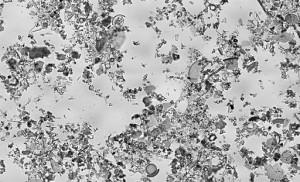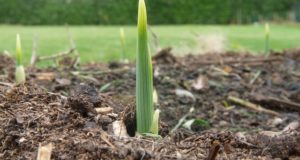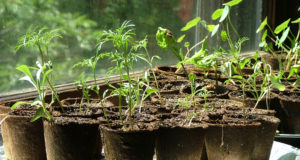|
Listen To The Article
|
Diatomaceous earth, or DE, is substance that has been around for literally millions of years. In terms of human history, DE has been used for thousands of years. In the US, its usefulness in the home, garden, and on the farm has only been recently rediscovered. It came back into use around forty years ago when farmers began putting DE in their animals’ feed. They find that the DE keeps the animals healthier by providing essential trace elements and by killing intestinal parasites. However, f you aren’t ready to start feeding dirt to your animals, you can try using it in the garden. DE acts like a natural pesticide. It enhances the soil to help your vegetables and plants grow better. It also can be used as a desiccant when you store your harvest.
>Discover God’s Miracle Dust…
What Is This Stuff?
 Diatomaceous earth is a type of chalky soil that begins as a soft rock. The rock is called diatomite, and it is made from the fossil remains of billions of little creatures called diatoms. These are single-celled algae. Diatoms still exist today and are a large component of all the algae in the world. Diatoms are incased in a shell of silica, and although each tiny one is a separate organism, they can join together to make a colony of diatoms. When diatoms from millions of years ago died, their silica shells remained behind. Over many years, layers of these shells built up in lake beds and on ocean floors. They were compressed together until a rock formed: diatomite.
Diatomaceous earth is a type of chalky soil that begins as a soft rock. The rock is called diatomite, and it is made from the fossil remains of billions of little creatures called diatoms. These are single-celled algae. Diatoms still exist today and are a large component of all the algae in the world. Diatoms are incased in a shell of silica, and although each tiny one is a separate organism, they can join together to make a colony of diatoms. When diatoms from millions of years ago died, their silica shells remained behind. Over many years, layers of these shells built up in lake beds and on ocean floors. They were compressed together until a rock formed: diatomite.
When diatomite is crushed up to make a powder, the result is diatomaceous earth. DE is largely made up of the silica shells of the diatoms with some trace elements as well. These can include iron, aluminum, copper, magnesium, manganese, molybdenum, tin, and many others. The silica is a compound made of silicon and oxygen with surrounding water molecules. When the DE is mined, it is left out in the sun to dry. This causes all the water molecules to evaporate, leaving the silica and trace elements behind as a dry powder.
There are two types of DE, commonly called swimming-pool grade and food grade. The former is so named because it is often used as a filter in swimming pools. This type of DE is very dangerous to handle and can cause serious harm. You should avoid it at all costs. For all of your needs around the garden, you want to use food-grade diatomaceous earth.
A Natural Pesticide
There is archaeological evidence that DE was used as far back as four thousand years in China as a pesticide. Here in the US we are a little late to the idea, but it is catching on. As we learn more about synthetic pesticides and the adverse effects they have on people, animals, waterways, and soil, a natural pesticide is very appealing. Food-grade diatomaceous earth is so safe that you can actually eat it. As a pesticide, you can feel free to use it liberally without harming your family, your pets, or any wildlife—except the insects, of course.
The shells of the diatoms that make up DE are very small and very sharp and pointy. When insects come into contact with them, the shells pierce their exoskeletons. Because the silica of the DE originally had water molecules attached but was dried out, it can absorb water very effectively. After piercing the insects, the silica dehydrates the insects and they die. The process is a completely physical one as opposed to most pesticides that use a harmful substance to kill the insects chemically. DE will kill any arthropod—that is, anything with that hard exoskeleton. It can potentially kill other creatures as well (such as snails and worms), depending on the amount used and the moisture in the environment.
In terms of arthropods, DE kills indiscriminately. Because some of the insects in your garden are beneficial, you should not use DE unless you have a particular pest to kill. If you simply sprinkle the DE all around the garden, you will kill all insects. If you have a particular vegetable that is under attack, you should treat it.
There are a couple of ways to kill pests around your plants with DE. If they are attacking the plant by crawling up to it from the ground, make a ring around the plant with DE. The insect will need to crawl through the powder to get to the plant. This may work on slugs as well. If your environment is very damp however, the ring of DE may not be enough to kill slugs.
If you have insects that are attacking the leaves of your plant, you can apply the DE directly to them. To make it stick to the leaves, you will need to make a mixture in water. Use about one part DE to three parts water and mix in a little bit of liquid dish soap. Use a spray bottle to apply the mixture to the affected leaves. In the case of aphids, apply to the underside of leaves. Be sure to shake the mixture in the spray bottle frequently. The DE will settle out quickly. Be sure to avoid flowers when you spray to avoid killing bees.
While most synthetic and chemical pesticides kill insects immediately, diatomaceous earth requires a little bit of patience. It will take a couple of days before the DE causes insects to dehydrate sufficiently that they are killed. It is worth the wait though, and as long as the DE stays in place, it will continue to work. You will only need to reapply after a rain.
A Soil Enhancer
Diatomaceous earth is also a great additive for your soil, and not just to control pests in the ground. It provides several minerals, including nitrogen, enhancing your soil and giving your plants the chance to take up more nutrients. Some of the trace elements in DE that are beneficial to plants include copper, titanium, magnesium, and boron. Even the silica itself is useful. Plants take up silica to strengthen their cell walls.
DE is also a great way to control moisture in your soil. Because DE absorbs water so well, it can take in and hold on to excess water. When the soil dries out, it releases its water. With DE in your garden soil, it is easier to avoid overwatering your plants or letting them dry out with too little watering.
As an added benefit, adding DE to your soil will help break it up if it is heavy and allow for more air flow. DE has a very low density and is porous. It is a great addition to soil that has a lot of clay. As a general rule, use about one part DE to four parts soil. You may want to experiment with potted plants first before adding it to your garden. Try different amounts to see what works best.
If you grow anything hydroponically, you might consider trying DE as a growing medium. You can purchase DE as small chunks of rock rather than as a powder for just this purpose. It works well with hydroponics because it can absorb, retain, and release water so well. It is also sterile, has a neutral pH, and can be used over and over again. You may find chunks of DE online or at the gardening store labeled as silica stones.
Food Storage
Once you have collected the bountiful harvest of your vegetable garden, you are faced with the prospect of storing it all. If you keep grains and vegetables in a cellar, basement, or storage barn, you can use diatomaceous earth to protect it. The absorbency of DE will keep moisture at bay and help your food to last longer. It will also eliminate the possibility of insects getting into your stores. You can put packets of DE right in your food containers to absorb moisture. You can also sprinkle it all around the storage area to kill pests.
Safety
Food-grade diatomaceous earth is extremely safe. It is recognized as safe to consume by animals and humans. The only possible danger it presents is by inhalation. As with any dust, inhaling DE can cause irritation in the throat, nose, and lungs. To avoid this, you may want to wear a paper mask when working with DE. Also avoid spreading it outside when it is windy. If you are using it in a liquid solution, inhalation won’t be a concern. You may also want to wear gloves when handling DE as it can dry out your skin.
Avoid swimming-pool grade DE at all costs. It can cause severe damage with just a little bit of inhalation. It can also cut and burn your skin. Never use this type of DE unless you are trained to do so and know what you are doing.
©2012 Off the Grid News
 Off The Grid News Better Ideas For Off The Grid Living
Off The Grid News Better Ideas For Off The Grid Living




